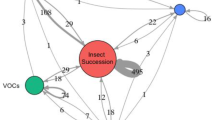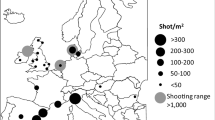Abstract
An exercise to compare 10 approaches for the calculation of unweighted whole-body absorbed dose rates was conducted for 74 radionuclides and five of the ICRP’s Reference Animals and Plants, or RAPs (duck, frog, flatfish egg, rat and elongated earthworm), selected for this exercise to cover a range of body sizes, dimensions and exposure scenarios. Results were analysed using a non-parametric method requiring no specific hypotheses about the statistical distribution of data. The obtained unweighted absorbed dose rates for internal exposure compare well between the different approaches, with 70% of the results falling within a range of variation of ±20%. The variation is greater for external exposure, although 90% of the estimates are within an order of magnitude of one another. There are some discernible patterns where specific models over- or under-predicted. These are explained based on the methodological differences including number of daughter products included in the calculation of dose rate for a parent nuclide; source–target geometry; databases for discrete energy and yield of radionuclides; rounding errors in integration algorithms; and intrinsic differences in calculation methods. For certain radionuclides, these factors combine to generate systematic variations between approaches. Overall, the technique chosen to interpret the data enabled methodological differences in dosimetry calculations to be quantified and compared, allowing the identification of common issues between different approaches and providing greater assurance on the fundamental dose conversion coefficient approaches used in available models for assessing radiological effects to biota.












Similar content being viewed by others
Notes
This is due to the fact that the data in the plot are normalized to the absorbed dose in a uniform infinite medium under a uniform isotropic model.
References
Allott R, Copplestone D, Merrill D, Oliver S (2009) Habitats assessment for radioactive substances. England & Wales Environment Agency Science Report SCO60083/SR
Beaugelin-Seiller K, Jasserand F, Garnier-Laplace J, Gariel JC (2006) Modeling radiological dose in non-human species: principles, computerization, and application. Health Phys 90(5):485–493
Beresford NA, Barnett CL, Brown J, Cheng JJ, Copplestone D, Filistovic V, Hosseini A, Howard BJ, Jones SR, Kamboj S, Kryshev A, Nedveckaite T, Olyslaegers G, Saxén R, Sazykina T, Vives i Batlle J, Vives-Lynch S, Yankovich T, Yu C (2008) Inter-comparison of models to estimate radionuclide activity concentrations in non-human biota. Radiat Environ Biophys 47(4):491–514
Beresford NA, Barnett CL, Brown JE, Cheng JJ, Copplestone D, Gaschak S, Hosseini A, Howard BJ, Kamboj S, Nedveckaite T, Smith JT, Vives i Batlle J, Vives-Lynch S, Yu C (2010) Predicting the radiation exposure of terrestrial wildlife in the Chernobyl exclusion zone: an international comparison of approaches. J Radiol Prot 30:341–373
Briesmeister JF (1997) MCNP—a general Monte Carlo N-particle transport code: version 4B”, LA-12625-M, version 4B.Report UC705, University of California, Los Angeles (US)
Brown JE, Alfonso B, Avila R, Beresford NA, Copplestone D, Pröhl G, Ulanovsky A (2008) The ERICA tool. J Environ Radioact 99(9):1371–1383
Copplestone D, Bielby S, Jones SR, Patton D, Daniel CP, Gize I (2001) Impact assessment of ionising radiation on wildlife. R&D Publication 128, Environment Agency, UK and English Nature
Copplestone D, Wood MD, Bielby S, Jones SR, Vives i Batlle J, Beresford NA (2003) Habitat regulations for Stage 3 assessments: radioactive substances authorisations. R&D Technical Report P3–101/SP1a. Environment Agency, Bristol 100 pp
Golikov V, Brown JE (2003) Internal and external dose models. Deliverable report 4 for EPIC. EC Inco-Copernicus project ICA2-CT-2000–10032. Norwegian Radiation Protection Authority, Østerås
IAEA (in press) EMRAS Biota Working Group: International comparison of models and approaches for the estimation of radiological exposure to non-human biota. In: Environmental modelling for radiation safety (EMRAS): a summary of the outcomes of the programme. International Atomic Energy Agency, Vienna
ICRP (2008) The concept and use for reference animals and plants for the purposes of environmental protection. In: J Valentin (ed) ICRP Publication 108. Ann ICRP 38 (4–6):76
Keum D-K, Jun I, Lim K-M, Choi Y-H (in press) External dose conversion coefficients to assess the radiological impact of an environmental radiation on aquatic and terrestrial animals. J Nucl Sci Tech
Taranenko V, Pröhl G, Gómez-Ros JM (2004) Absorbed dose rate conversion coefficients for reference biota for external photon and internal exposures. J Radiol Prot 24:A35–A62
Ulanovsky A, Pröhl G (2006) A practical method for assessment of dose conversion coefficients for aquatic biota. Radiat Environ Biophys 45(3):203–214
Ulanovsky A, Pröhl G, Gomez-Ros JM (2008) Methods for calculating dose conversion coefficients for terrestrial and aquatic biota. J Environ Radioact 99:1440–1448
USDOE (2002) A graded approach for evaluating radiation doses to aquatic and terrestrial biota. Technical Standard DOE-STD-1153–2002. Department of Energy, Washington, DC
Vives i Batlle J, Jones SR, Gomez-Ros JM (2004) A method for calculation of dose per unit concentration values for aquatic biota. J Radiol Prot 24(4A):A13–A34
Vives i Batlle J, Balonov M, Beaugelin-Seiller K, Beresford NA, Brown J, Cheng J-J, Copplestone D, Doi M, Filistovic V, Golikov V, Horyna J, Hosseini A, Howard BJ, Jones SR, Kamboj S, Kryshev A, Nedveckaite T, Olyslaegers G, Pröhl G, Sazykina T, Ulanovsky A, Vives-Lynch S, Yankovich T, Yu C (2007) Inter-comparison of unweighted absorbed dose rates for non-human biota. Radiat Environ Biophys 46(4):349–373
Vives i Batlle J, Jones SR, Copplestone D (2008) Dosimetric model for biota exposure to inhaled radon daughters. Science Report SC060080. Environment Agency, Bristol, 34 pp
Westinghouse (2010) UK AP1000 environment report. UKP-GW-GL-790 Report Revision 3, 350 pp. Available from https://www.ukap1000application.com/doc_pdf_library.aspx. Accessed 22/11/2010
Wood MD, Beresford NA, Barnett CL, Copplestone D, Leah RT (2009) Assessing radiation impact at a protected coastal sand dune site: an intercomparison of models for estimating the radiological exposure of non-human biota. J Environ Radioact 100:1034–1052
Yankovich TL, Vives i Batlle J, Vives-Lynch S, Beresford NA, Barnett CL, Beaugelin-Seiller K, Brown JE, Cheng J-J, Copplestone D, Heling R, Hosseini A, Howard BJ, Kamboj S, Kryshev T, Nedveckaite T, Smith JT, Wood MD (2010) An international model validation exercise on radionuclide transfer and doses to freshwater biota. J Radiol Prot 30:299–340
Acknowledgments
The authors would like to thank the IAEA for organizing the EMRAS II programme, most especially our scientific secretary Sergey Fesenko, and all other participants of the Biota Modelling Group (http://www-ns.iaea.org/projects/emras/emras2/working-groups/working-group-four.asp) who have commented upon this work. We would also like to thank Professor S.R. Jones for useful advice on the model intercomparison methodology.
Author information
Authors and Affiliations
Corresponding author
Rights and permissions
About this article
Cite this article
Vives i Batlle, J., Beaugelin-Seiller, K., Beresford, N.A. et al. The estimation of absorbed dose rates for non-human biota: an extended intercomparison. Radiat Environ Biophys 50, 231–251 (2011). https://doi.org/10.1007/s00411-010-0346-5
Received:
Accepted:
Published:
Issue Date:
DOI: https://doi.org/10.1007/s00411-010-0346-5




